This Vegan Sweet Potato Chocolate Fudge Cake is rich, chocolatey, moist and surprisingly easy to make. Plus, it’s gluten free, dairy free, nut free and eggless. Perfect if you need a healthy alternative to regular chocolate cake that still tastes indulgent.
The cake starts with two layers of chocolate cake, which are sandwiched together with generous layers of chocolate fudge frosting. I love to make the cake with two layers, but you can also halve the recipe to make a thinner, single layer cake. Both versions are delicious.
How to make chocolate cake vegan and gluten free
I keep this chocolate cake vegan by using a few ingredient swaps. First, sweet potato holds the cake together instead of eggs. Second, I use a combination of baking powder, baking soda and apple cider vinegar to give the cake some rise. Third, I use avocado in the chocolate fudge frosting to replace the need for butter.
The chocolate cake is also gluten free thanks to buckwheat flour. I often use buckwheat flour as a wholesome alternative to all-purpose flour in gluten-free cake recipes. However, you can use all-purpose flour instead of buckwheat flour if you don’t need the cake to be gluten free.
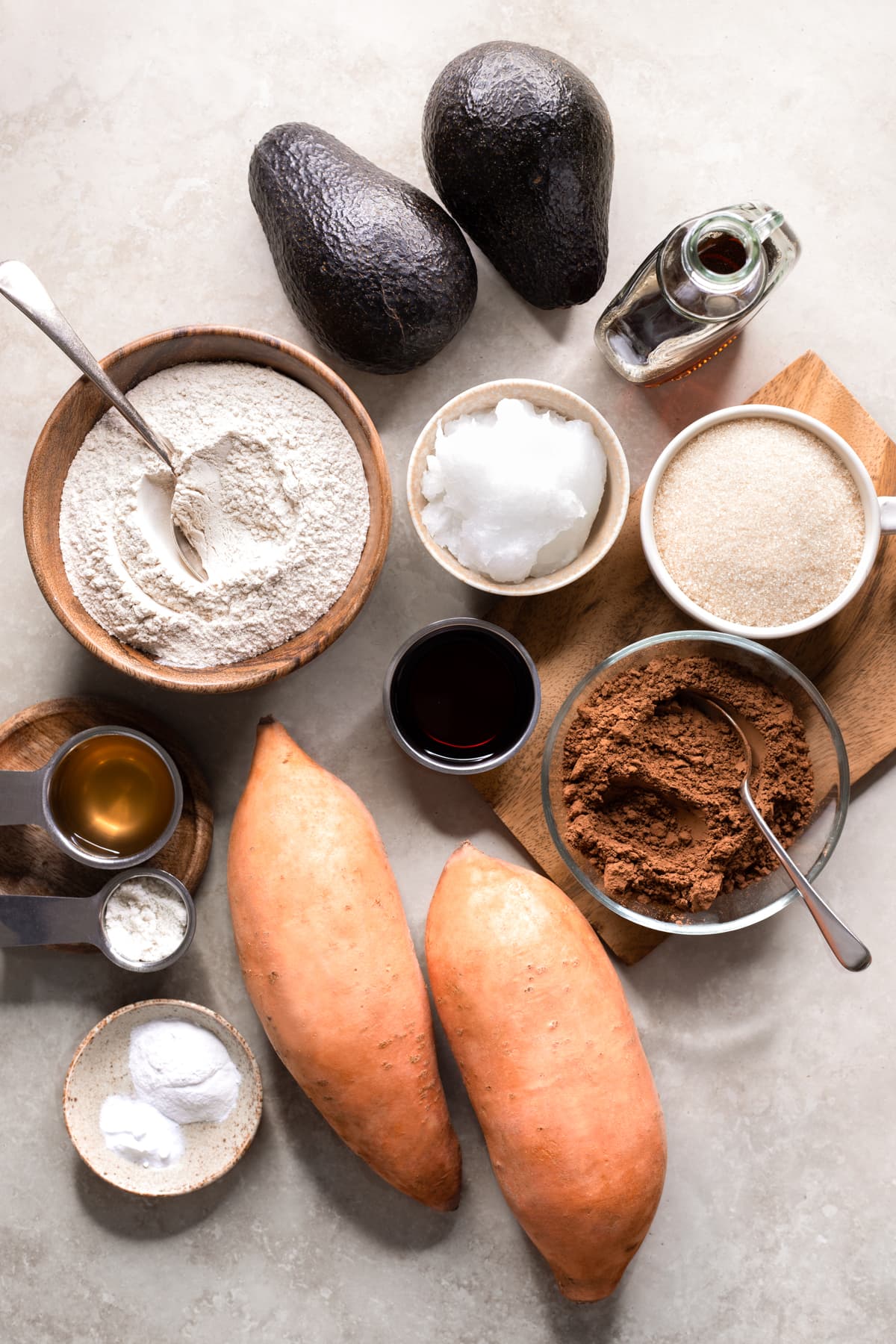
What is the difference between chocolate cake and chocolate fudge cake?
Regular chocolate cake has a light crumb, whereas chocolate fudge cake is richer and more dense in texture. Most chocolate fudge cakes will use a combination of butter and melted chocolate to get a fudgy texture.
However, in this vegan recipe, sweet potato gives the chocolate cake a fudgy texture. You also get the added benefit of boosting the cake with additional nutrients and fiber. Plus, it keeps the cake dairy free for people who are sensitive to lactose.
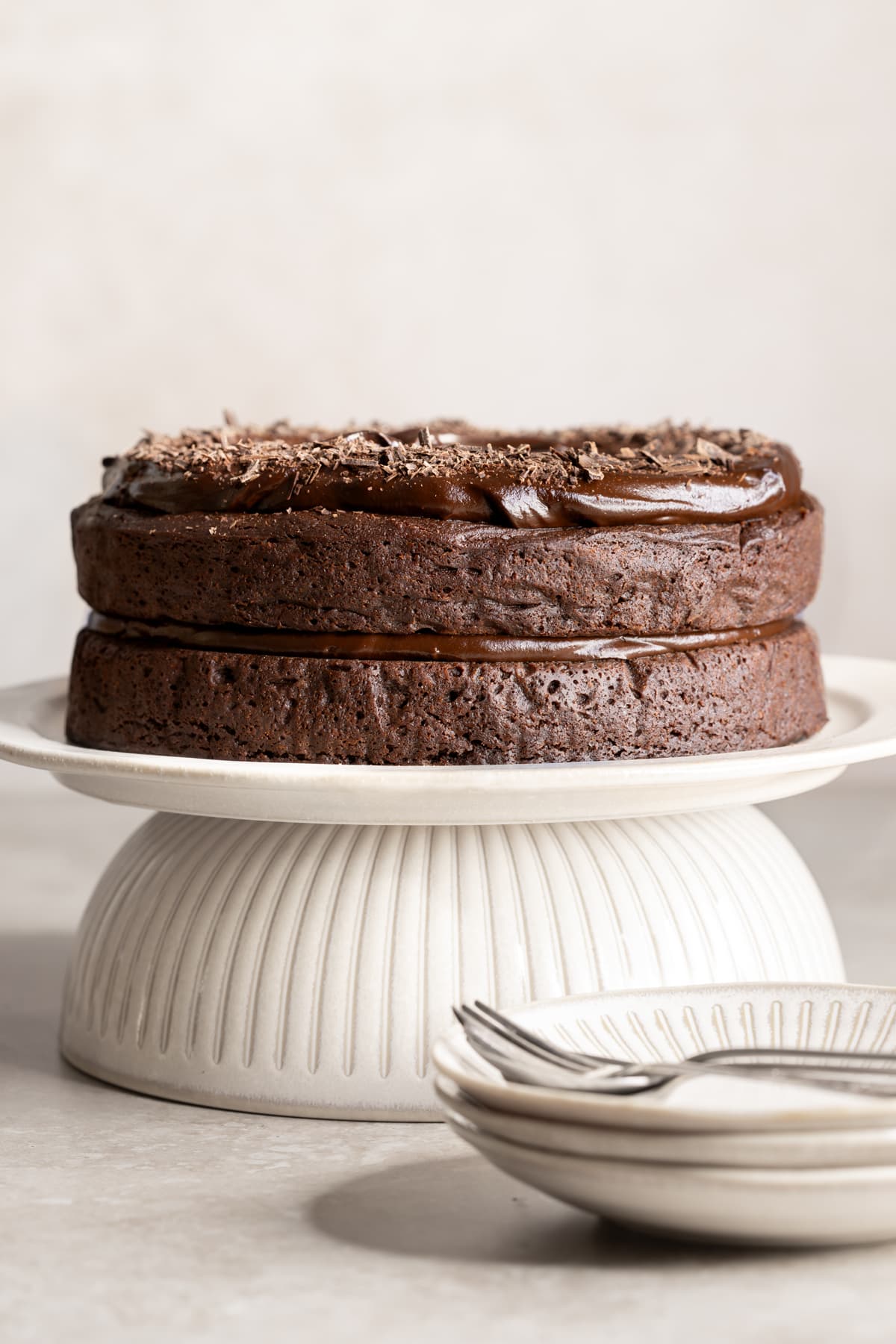
How do you make a vegan cake moist?
Sweet potato keeps this vegan chocolate fudge cake super moist. It replaces the need for dairy ingredients like yogurt or sour cream, which are often used to keep chocolate cakes moist.
Using sweet potato in vegan baking recipes also helps to bind the mixture instead of using eggs. Plus, it allows you to use less flour, which reduces the risk of drying out the cake.
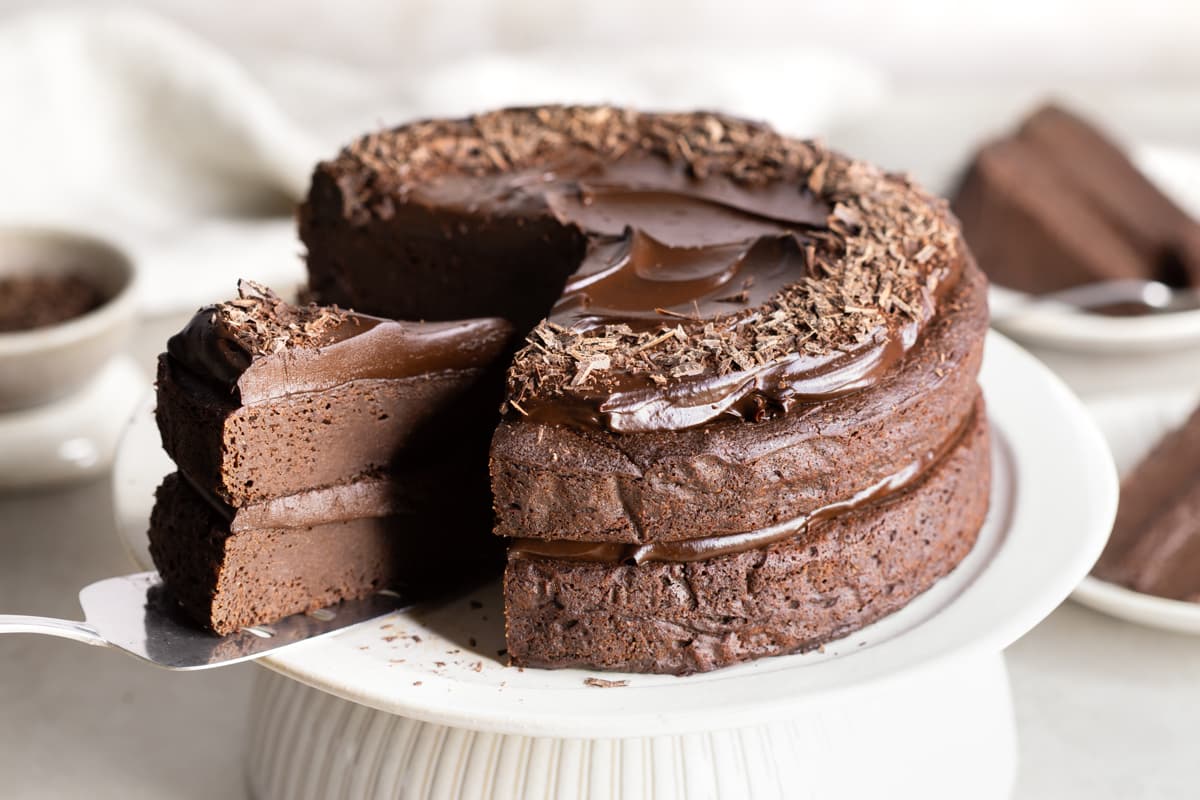
Ingredients for vegan sweet potato chocolate fudge cake
- Sweet potato: Baked sweet potato flesh gives the chocolate cake its beautiful fudgy texture. I have included instructions on how to bake your sweet potatoes in the oven or the microwave in the recipe notes below.
- Coconut oil: Coconut oil keeps the chocolate cake vegan and dairy free. We also use it in the frosting to help it set with a soft and fudgy texture.
- Raw sugar: I use raw sugar to sweeten the cake. You could use regular granulated sugar if you prefer.
- Buckwheat flour: Using buckwheat flour in the cake keeps it gluten free. You can use all-purpose flour as a substitute if you don’t need the cake to be gluten free.
- Cocoa powder: I recommend Dutch processed cocoa powder for this recipe. It gives a smooth chocolate flavor. However, regular unsweetened cocoa powder or raw cacao powder will both also work.
- Avocado: Ripe avocado flesh gives the chocolate fudge frosting a super creamy and rich texture without the need for butter. It also provides a boost of healthy fats.
- Maple syrup: I use maple syrup to sweeten the frosting. Honey should also work well if you don’t mind a subtle honey flavor.
- Vanilla extract: Vanilla adds depth of flavor to the cake and the frosting. I prefer vanilla extract over essence if you can get it.
- Apple cider vinegar: Vinegar works with the baking soda to give the cake some rise. The cake doesn’t rise a lot though, since it’s a dense and fudgy cake.
- Baking soda: Also known as bicarbonate of soda or bi carb soda, baking soda reacts with the vinegar to give the cake some lift.
- Baking powder: Baking powder also helps to give the cake some lift.
- Salt: I always add salt to chocolate recipes. It really does enhance the flavor of the cake and the frosting. I highly recommend that you include it.
- Dark chocolate (optional): I love decorate the cake with grated dark chocolate. However, the cake still looks beautiful without it.
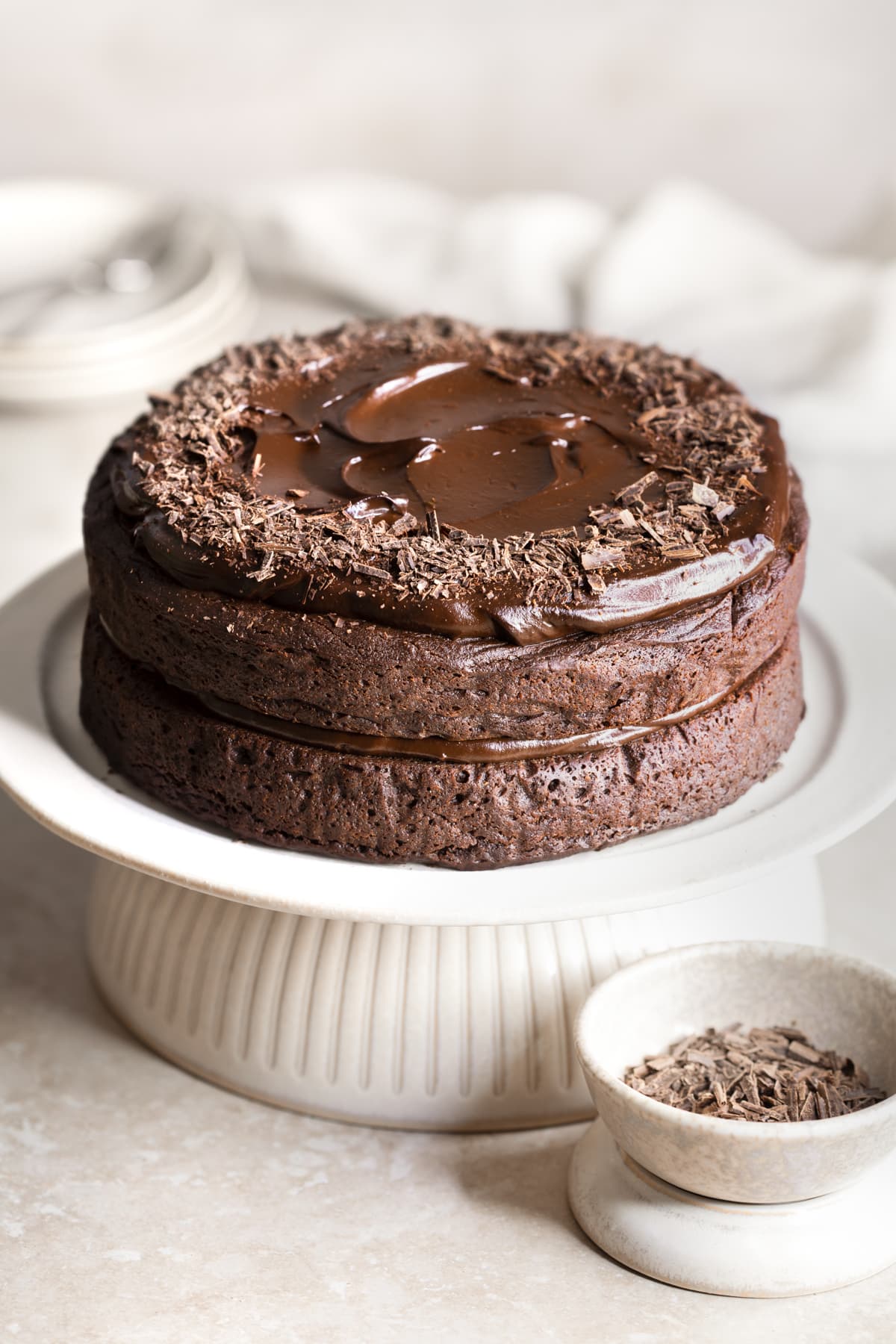
More healthy cake recipes
- Gluten Free Gingerbread Cake without Molasses
- No Bake Vegan Lime Cheesecake
- Gluten Free Pumpkin Bread without Dairy
- Gluten Free Apple Cake with Buckwheat Flour
- Vegan Sweet Potato Bread with Chocolate Chips
Check out the Baking Recipes page more healthy cake ideas.
Vegan Sweet Potato Chocolate Fudge Cake Recipe
Serves
16 slices
Prep time
15 mins
Cook time
35 mins
Ingredients
For the cake:
- 3 cups / 680 g baked sweet potato flesh (see Note 1)
- 2/3 cup / 160 ml / 140 g coconut oil, softened
- 1 cup / 200 g raw sugar
- 4 tsp apple cider vinegar (or white vinegar)
- 2 tbsp / 30 ml vanilla extract
- 1/2 cup / 120 ml / 120g water
- 1 1/2 cup / 180 g buckwheat flour (see Note 4)
- 1/2 cup / 60 g cocoa powder (see Note 5)
- 1 1/2 tsp fine salt
- 2 tsp baking powder
- 1/2 tsp baking soda
For the frosting:
- 2 small ripe avocados, to give 10 oz / 280 g flesh
- 1/2 cup / 60 g cocoa powder (see Note 5)
- 1/2 cup / 120 ml / 160 g maple syrup
- 1/4 cup / 60 ml / 54 g coconut oil, melted
- 1 tsp vanilla extract
- Pinch of fine salt
- Dark chocolate, grated for decoration (optional)
Method
- Preheat your oven to 160°C fan-forced / 180°C / 350°F and line two 8 inch / 20 cm round cake tins with baking paper.
- Place the sweet potato flesh, coconut oil, sugar, vinegar, vanilla and water in a large mixing bowl. Blend with a hand blender until smooth. Alternatively, you can do this in a food processor.
- Add the flour, cocoa powder, salt, baking powder and baking soda and fold through until just combined. Spoon the mixture evenly between the two lined cake tins, smoothing out the tops with the back of a spoon.
- Bake in the preheated oven for 35 to 40 minutes or until a toothpick inserted in the middle of each cake comes out clean. Cool slightly in the tins, then transfer the cakes to a wire rack to cool completely.
- Once the cakes are completely cold, make the frosting. Place the avocado flesh and remaining frosting ingredients into a mixing bowl and blend with a hand blender until completely smooth. Alternatively, you can do this in a food processor.
- To assemble, place one cake upside down on a serving plate. Spread half of the frosting over the cake, taking it just shy of the edges. Place the second cake on top, the right way up. Press down gently so the frosting squishes out to the edges. Spread the remaining frosting on top. Chill in the fridge until ready to serve. The frosting will firm up slightly in the fridge, which makes the cake easier to cut.
Notes
- Sweet potato – You will need about 3.3 lb / 1.5 kg raw weight sweet potatoes to get enough cooked flesh for this recipe. Bake the sweet potatoes in the oven or a microwave, then extract the flesh to measure out.
- How to bake sweet potato – Prick the potatoes all over with a fork, place on a baking tray and bake in a 180°C fan-forced / 200°C / 400°F oven for 30 to 40 minutes or until a knife inserted into the thickest part of each potato slides through easily.
- How to microwave sweet potato – Prick the potatoes all over with a fork, place on a microwave safe plate and microwave for about 30 minutes or until soft, flipping the potatoes over half way. You want a knife inserted into the thickest part of each potato to slide through easily.
- Flour – You can use all-purpose flour instead of buckwheat flour if you don’t need the cake to be gluten free. For best results, I recommend weighing your flour in grams on a food scale because cup measures can be unreliable when measuring flours.
- Cocoa powder – I like to use Dutch processed cocoa powder in this recipe for a smooth chocolate flavor. Regular cocoa powder and raw cacao powder will also work, but they are slightly more bitter in flavor.
- Storage – Store the cake in an airtight container in the fridge for up to 3 days. You can freeze any leftovers and defrost in the fridge as needed.
- Single layer cake – You can halve the recipe to make a single layer cake in one 8 inch / 20 cm round cake tin.
Nutrition Facts
- Serving size: 1 slice
- Energy: 335 Calories / 1402 Kilojoules
- Total Fat: 16.9 g
- Saturated Fat: 11.1 g
- Total Carbohydrate: 41.7 g
- Dietary Fiber: 4.4 g
- Sugars: 21.3 g
- Protein: 4.5 g
- Sodium: 317 mg
- Potassium: 149 mg
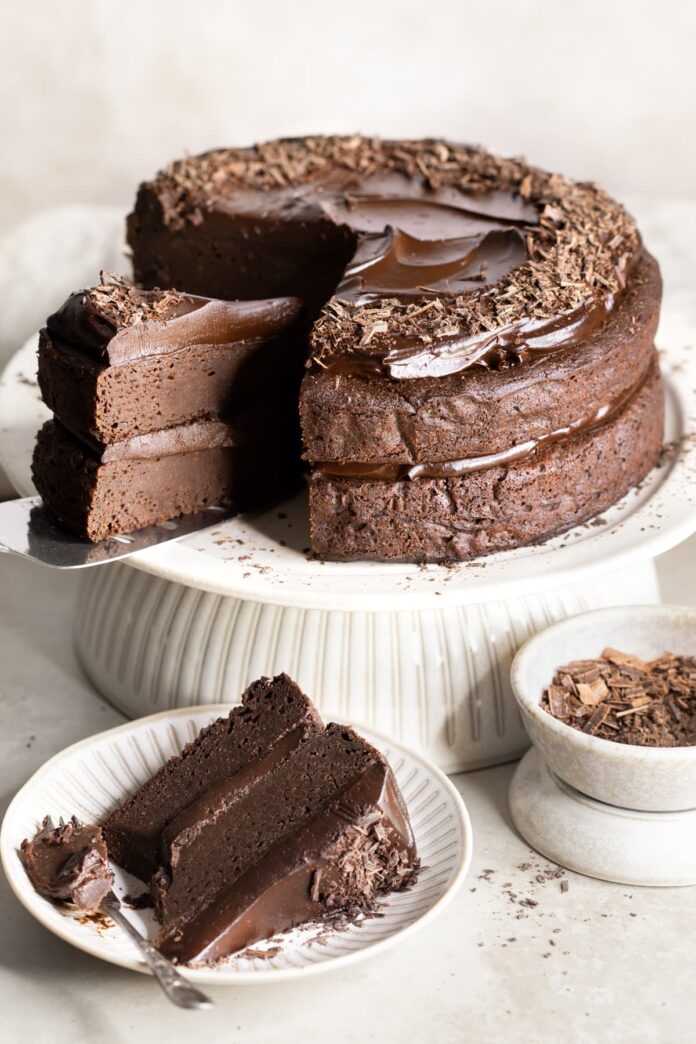
I cannot have apple cider vinegar.
Would lemon juice work?
Would replacing raw sugar with coconut sugar work?
Yeah, lemon juice in place of the apple cider vinegar and coconut sugar in place of the raw sugar should work.
Can I sub:
– olive oil for coconut oil
– jaggery / dates for sugar
– oats / almond flour for all-purpose
– regular vinegar/ rice vinegar for ACV?
Love the photos and how detailed your recipe is!
Waiting for your reply!
Thanks! I haven’t tested the recipe with those substitutions, but these are my thoughts:
– olive oil should work instead of coconut oil, but it may give the cake a more earthy flavor
– you could try blending 1 cup of date paste into the mixture instead of the raw sugar, but it might change the texture of the cake and affect the cooking time slightly due to the moisture content of the date paste
– the recipe uses buckwheat flour rather than all-purpose, but 180 grams of oat flour or 180 grams of rolled oats blended into a flour consistency should work as a substitute (I recommend using gram measurements when substituting flours)
– regular white vinegar can certainly be used instead of ACV
I hope that helps!